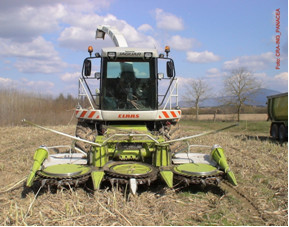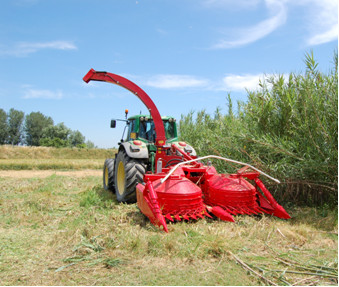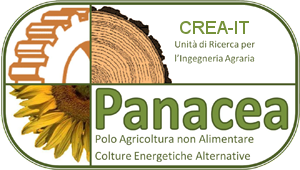The research aim is to develop mechanical systems both for the implant step that for the harvesting of giant reed trying to use methodologies and traditional means in order to contain production costs. For energy purposes, the giant reed is usually collected by adapting the most common self-propelled forage harvesters (Claas Jaguar equipped with RU450Xtra header). The best results has been obtained with machines employed for the harvesting of silage maize, showing an effective field capacity slightly higher than an hour per hectare.
The feedstock produced, however, presents a high level of moisture and an excessive presence of fine fractions (below the centimeter), factors that limit a suitable conservation (increasing risk of harmful fermentations) and its immediate utilization via thermo-valorization. Particle size is a main factor in determining the air permeability of a stored biomass and affects the speed and degree of drying under any given conditions. Although reducing the bulk density, a greater dimensions of the particles thanks to a better permeability, favors the moisture loss and restrains the fermentative phenomena, thus improving the final quality.
One of the solutions to be adopted, to remedy the limitations highlighted by the methodology described, could be that of intervening on the machine system chopping, the rotor, going to change the number of the knives, reducing it, in order to obtain a larger size product and presumably also of better quality.
 As part of the research project OPTIMA (www.optimap.7.eu) funded by the EU, Panacea group, in collaboration with the Spapperi Ltd, has designed a prototype of Arundo harvester mounting a specific rotor for comminuting the plants in longer pieces.
As part of the research project OPTIMA (www.optimap.7.eu) funded by the EU, Panacea group, in collaboration with the Spapperi Ltd, has designed a prototype of Arundo harvester mounting a specific rotor for comminuting the plants in longer pieces.
The machine is composed of two main parts: i) a cutting system and conveying vertical rotors fitted with basal blades and ii) a chipping system with disc rotating on horizontal axis equipped with two knives in radial position. Interposed between the two components, a feeding system with counter-rotating toothed rollers having the function of picking up and supplying the chipping system has been inserted.
The chipping system recalls the typology of the forestry chippers on which, in order to increase the cutting length, some modifications on the positioning of the main disc holders and the blade holder have been made, increasing the cutting opening. The functional scheme foresees the use of a tractor with reversible drive and a trailer moving parallel to the machine where the chopped material is discharged from the chipping system by means of a swiveling goose-neck. The prototype was initially set on a surface separated from those interested to the test. The speed of the feeding rolls was adjusted in order to reduce the risk of plugging.
In both cases a tractor-trailed unit received the chopped material from the harvesters and moved them to a collection point where the load was discharged.
A work was carried out to analyze the shredded product characteristics obtained respectively from the prototype or self-propelled forage harvester.
The tested prototype has proved to be suitable for the harvesting of the giant reed and for the increasing of the particle size distribution of chopped Arundo, thus demonstrating that the technical choice in the developing the prototype, the mechanical modification applied to a common forestry chipper, have led to the achievement of the goal. Comminution is an essential element of all modern energy wood chains, requiring the massive mobilization of renewable but perishable biomasses. In the case of Arundo, the main benefit of the increased load density finds a limit in the alterability of the feedstock quality during the storage.



